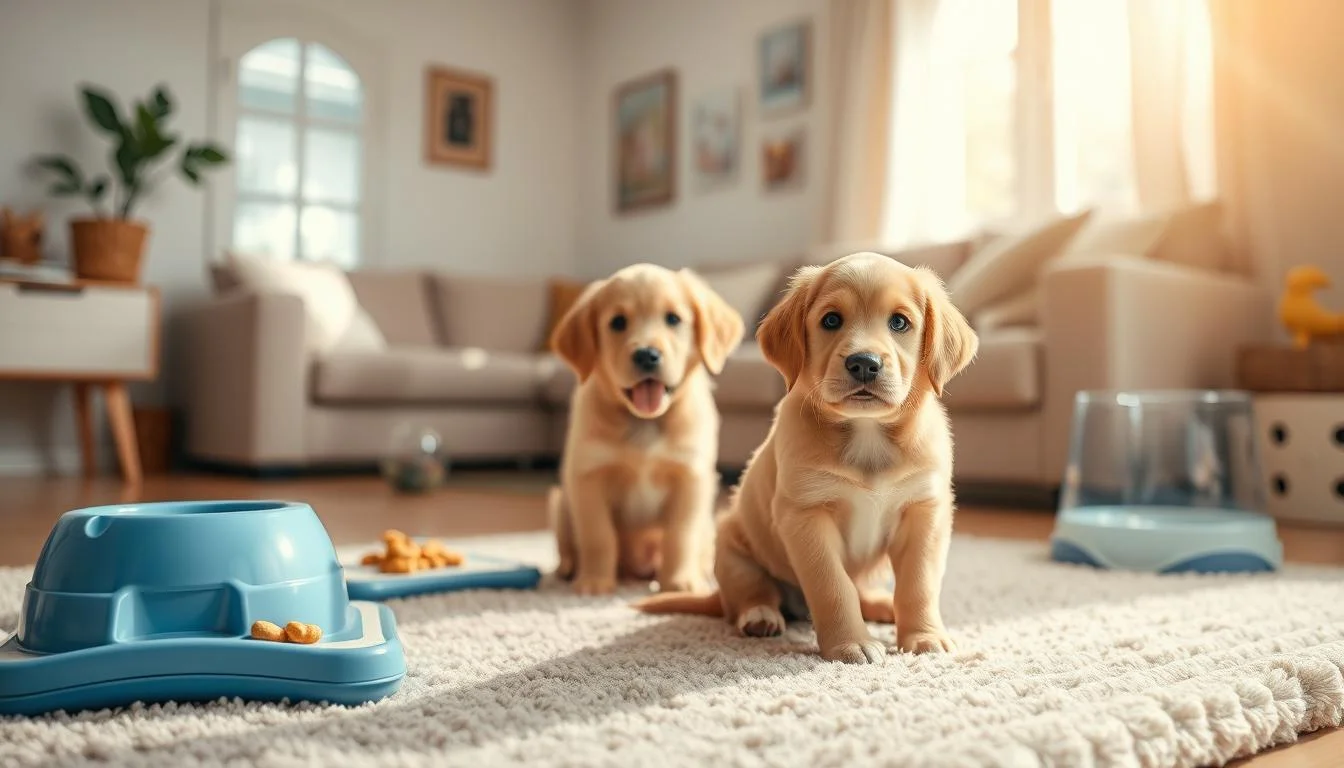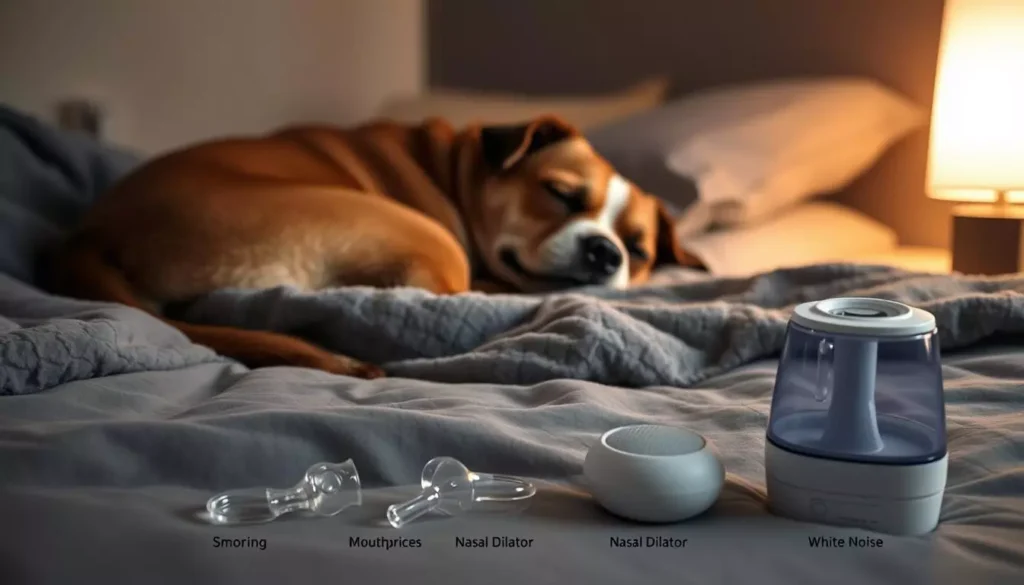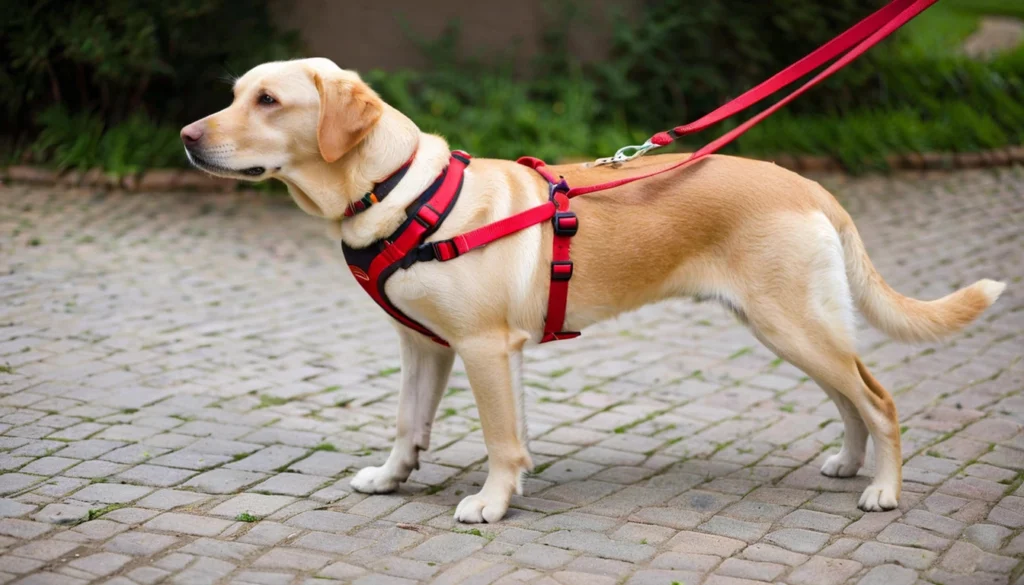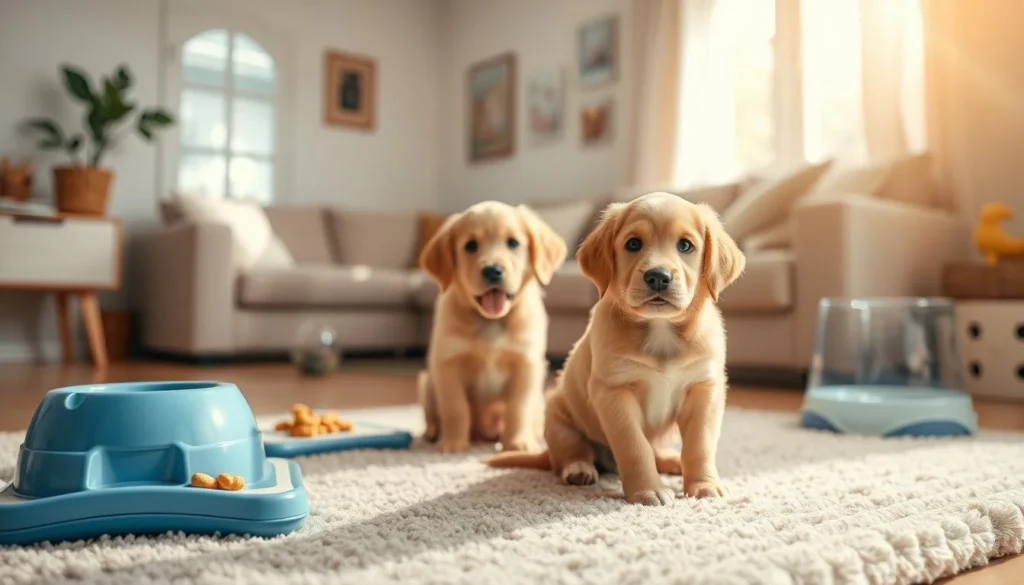I remember the first night my puppy arrived. She had a tiny nose pressed to the crate, softly whimpering. I felt joy and panic, knowing housetraining was key for our life together.
That first night was a rush of learning her rhythms and cleaning up accidents. It showed me how crucial a good plan is for new dog owners in the United States.
This guide is for those seeking practical, proven steps for puppy potty training. I'll share the best tips I've used and researched. You'll learn about scheduling, the right supplies, and more.
Experts like Mary Burch, Ph.D., from the American Kennel Club, agree on three main principles. These are repetition, consistency, and positive reinforcement. They work for all breeds and ages.
Remember, housebreaking time varies based on age, temperament, and history. But with a steady plan, most puppies learn in weeks to months.
Key Takeaways
- Start preparation before bringing your puppy home: plan a schedule and gather supplies.
- Use repetition, consistency, and positive reinforcement as core training tools.
- Rely on trusted resources like the AKC GoodDog Helpline and vet guidance.
- Expect gradual progress—most puppies housebreak in weeks to months.
- Keep supplies handy: crate, enzymatic cleaner, leash, treats, and puppy pads if needed.
Why early potty training matters for puppies
The first weeks with a new puppy are crucial. Starting potty training early helps puppies learn quickly. I use simple steps that combine consistency, patience, and the best tips for potty training a puppy to keep progress steady.
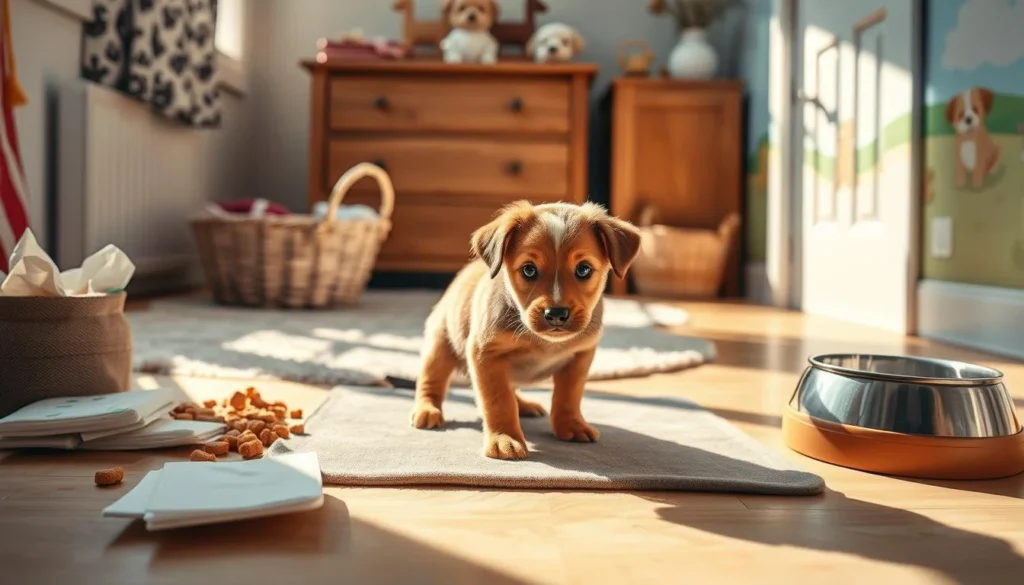
Health and hygiene benefits
Early housetraining reduces indoor odors and bacteria. Clean routines and enzymatic cleaners stop re-marking and protect floors and rugs.
Watching stool consistency and urine color helps me spot dietary problems or infections fast. Prompt vet checks when something seems off prevent bigger health issues.
How housetraining shapes long-term behavior
Consistent routines teach bladder and bowel control. They create predictable expectations in a household. Housetraining becomes a framework that supports leash training, impulse control, and other cues.
I avoid harsh scolding because it can create anxiety or secretive elimination. Positive reinforcement builds trust and makes effective housebreaking methods work faster.
Preparing before you bring your puppy home
I recommend researching crate training, puppy pads, and scheduled feeding so you enter day one with a plan. Buying the right supplies—crate with partitions, quality puppy food, pads, leash, and enzymatic cleaner—keeps you ready for setbacks.
Pick indoor and outdoor potty spots ahead of time and decide whether pads are temporary for tiny breeds or winter months. Arrange supervision or a dog walker if you will be away. I look for trusted trainers and online courses when I need extra puppy toilet training advice.
| Prep Item | Purpose | When to Use |
|---|---|---|
| Crate with partitions | Teaches den-restraint and prevents roaming | From day one through puppy months |
| Puppy pads | Provides an indoor option for tiny breeds or bad weather | Temporary use during harsh winters or limited outdoor access |
| Enzymatic cleaner | Removes odors that cause re-marking | After every accident to prevent repeat soiling |
| Scheduled feeding | Makes potty breaks predictable | Start immediately to establish routine |
| Quality puppy food | Supports consistent stool quality and health | Ongoing; consult vet if issues arise |
| Local trainer or course | Offers guidance on methods and troubleshooting | When you need extra support or structured programs |
Crate training as an effective housebreaking method
I highly recommend crate training for new puppy owners. It's a reliable method that taps into a dog's natural den instincts. This gives puppies a clean, secure spot to sleep, preventing accidents inside.
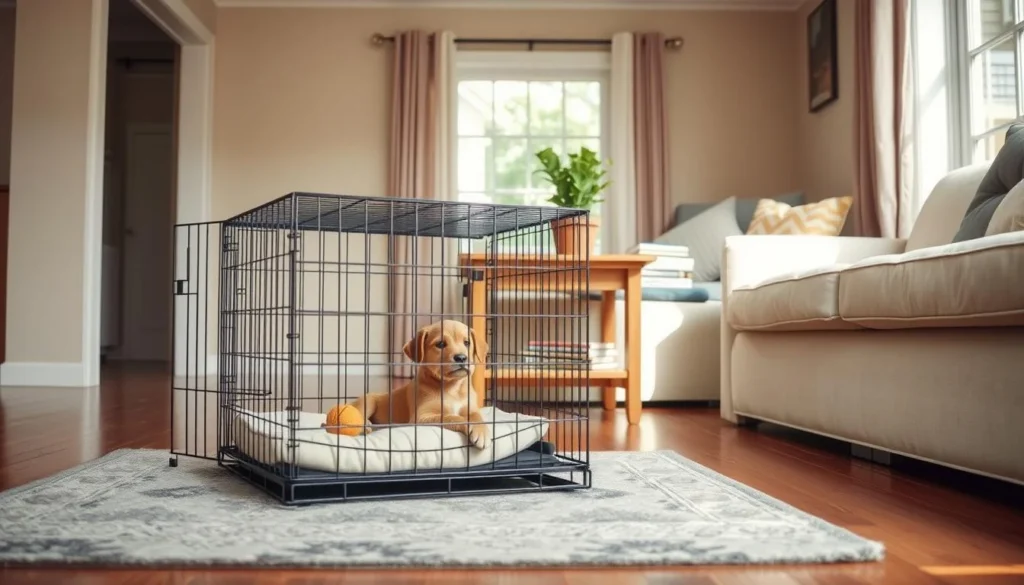
Choosing the right crate size is crucial. It should be just big enough for the puppy to stand, turn around, and lie down. For wire or plastic crates, I suggest using partitions to reduce space as the puppy grows. A crate that's too large can lead to accidents in one corner, which is not good for housebreaking.
Use the crate for naps, when you're not home, and at bedtime. I never use it for punishment. The crate time should match the puppy's bladder control. A good rule is the puppy's age in months plus one hour. If a rescued dog soils the crate, I go back to a strict schedule and calm training, not punishment.
Why crates work: den instincts and cleanliness
Crates work because dogs don't want to soil their sleeping area. I make sure the bedding is clean and provide short breaks. This teaches them that outside is where they should go. Crate training is a key part of expert puppy potty training strategies.
Choosing the right crate size and using partitions
Measure your puppy and choose a crate that fits their current size, not their adult size. I use partitions to make the space smaller as the puppy grows. This helps prevent confusion and supports top-rated tips for housebreaking your new puppy.
When to use the crate and avoiding overuse
Crate time should be predictable and humane. I limit long stretches alone and increase bathroom breaks for young pups. If accidents happen in the crate, I reassess the schedule, crate size, and stressors. This approach keeps crate training practical and effective.
Creating a consistent potty training schedule
I create a daily plan for puppies to learn when and where to go. This plan helps avoid accidents and boosts their confidence. I use small, predictable times to make it easy for owners to follow.
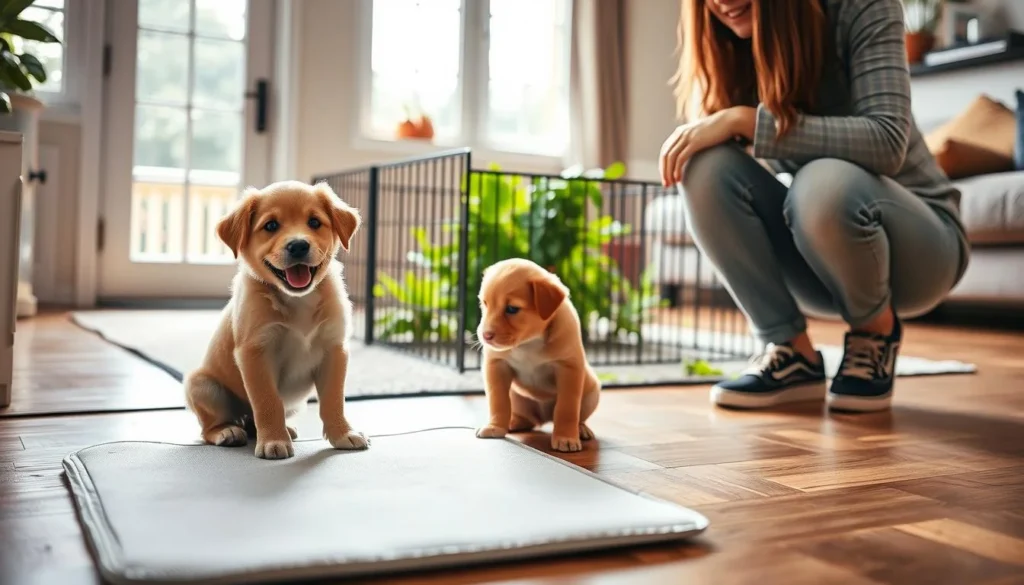
Timing by age: bladder control guideline
A puppy can hold urine for about its age in months plus one hour. For example, a four-month-old can hold for four to five hours. Puppies under eight weeks might need to go every one to two hours.
Key potty moments: after waking, eating, play, and crate time
I plan for puppies to go after waking, eating, playing, and napping. They often go when excited or after chewing. This helps prevent accidents.
Adjusting a schedule for workdays and dog walkers
I suggest getting a dog walker or neighbor for long days. If that's not possible, I use puppy pads near doors. This keeps the puppy's habit of going outside.
| Age | Typical Maximum Hours | Recommended Trip Frequency | Key Moments to Schedule |
|---|---|---|---|
| 6–8 weeks | 1–2 hours | Every 1–2 hours | After waking, after feeding, brief play, after crate |
| 2–3 months | 2–3 hours | Every 2–3 hours | After naps, meals, play sessions, crate breaks |
| 4–6 months | 4–6 hours | Every 3–5 hours | Morning wake, post-meal, post-play, before bedtime |
| 6–12 months | 6–8 hours | Every 4–6 hours | Consistent morning and evening trips, midday walk or walker |
| Working owners | Varies | Midday visit + morning and evening trips | Coordinate with walker; use pads short-term while training outside |
I incorporate the best tips for potty training into my schedules. This helps owners follow a daily routine. These routines are based on top-rated tips for housebreaking your new puppy.
Positive reinforcement techniques for fast learning
I use short, clear rewards to teach my puppy where to go. Positive reinforcement works best when it's consistent and timely. Small treats, lively praise, or a quick play session after a successful outing help build strong habits.
Here are some practical steps I use at home. They are based on successful puppy toilet training techniques and the best tips for potty training a puppy. I've tested them with different breeds.
Using treats, praise, and play effectively
I carry tiny, high-value treats like small pieces of cooked chicken or store-bought training bites. I reward the puppy within seconds of finishing to link action and reward. For some dogs, I combine a joyful "Good potty!" with a two-second play burst instead of food.
Evening rewards are calmer. I give a soft praise or a single tiny treat so the puppy stays settled for bedtime. This prevents them from getting overexcited from play.
Choosing reward timing and avoiding accidental reinforcement
Timing is key. I wait to reward until the puppy has finished eliminating so they learn the right spot causes good things. If an accident happens indoors, I clean quietly and avoid scolding. Any attention can teach the wrong lesson.
I avoid play or treats right before going back inside. A calm return helps the puppy settle and reduces the chance of repeating the behavior in the house.
Building a cue word like "potty" or "bathroom"
I pick one short cue and use it every trip to the toilet spot. I say the cue as the puppy starts to sniff and walk, then reward after elimination. Repeating this pairing makes the cue trigger the behavior over time.
Leashing and guiding the puppy to the same spot helps the association form faster. This method fits with expert puppy potty training strategies and rounds out the best tips for potty training a puppy for steady success.
Recognizing your puppy’s signals and preventing accidents
I keep a close eye on my puppies to catch the small signs they need to go. Learning these cues helps reduce accidents and speeds up training. Consistency is key when following puppy toilet training advice.
Common potty signals to watch for
Puppies often sniff the floor, circle, or get restless before they need to go. Some pace, whine, or scratch at the crate. Others freeze and squat.
I pay attention to which signals my puppy uses most. This helps me act fast to prevent accidents. These observations are crucial when following the best puppy potty training tips.
Supervision, tethering, and limiting freedom until trained
I don't let my puppies have free rein too soon. Close supervision helps prevent mistakes and teaches them to signal. When I'm busy, I use tethering or a small playpen to keep them close.
Crate time and short, supervised outings help with control. I limit freedom until my puppy reliably signals or uses the right spot. These practices are among the best tips for potty training a puppy.
What to do if you catch an in-progress accident
If I catch a puppy in the act, I interrupt calmly and take them to the potty area. If they finish outside, I praise them or give a small treat right away.
I never scold after the fact. Instead, I clean the indoor spot with an enzymatic cleaner to remove scent cues. Using patient, consistent puppy toilet training advice keeps the learning positive and effective.
Puppy pads, indoor options, and transitioning outside
I use indoor solutions when weather, breed size, or schedules make outdoor trips unreliable. Puppy pads can protect floors and give a clear indoor spot for tiny breeds or during deep winter. I recommend a steady plan so the pad serves as a bridge, not a long-term habit.
I pick locations near an exit when I need the puppy to learn an outdoor routine later. One method is to move the pad a few inches toward the door each day until it sits outside. I pair that shift with the same cue word and praise to reinforce outdoor success.
I avoid mixed signals by keeping consistency in timing and rewards. If I use indoor potties or grass patches, I treat them as temporary tools. For toy breeds with small bladders and for owners who rely on dog walkers, pads offer practical relief while following the best puppy potty training tips.
I use a phased removal plan for pads. First, I shrink the pad area or remove layers so the puppy adjusts to a smaller target. Next, I replace the pad with an outdoor trip on the same schedule and cue. When the pup eliminates outside, I reward immediately to cement the behavior.
For males and larger breeds, indoor grass patches or litter-style trays can work short term. I switch from those options to outside trips once the pup shows reliable responses to the potty cue. This approach follows top tips for training your puppy to potty outside while keeping accidents low.
I share practical puppy toilet training advice with new owners: stay patient, keep sessions regular, and celebrate small wins. Using pads smartly can speed early success without confusing your puppy about where toileting belongs in the long run.
Monitoring diet, feeding schedule, and bowel consistency
I focus on how food and timing shape potty habits. A steady feeding routine makes bathroom breaks predictable and cuts down accidents. I keep meals regular, watch water intake, and track stools to spot issues early.
I feed most puppies three small meals a day, spaced evenly. Puppies usually eliminate soon after eating, so set meals create reliable potty windows. I pair meal times with outdoor trips to build the routine behind the best puppy potty training tips.
I prioritize high-quality puppy formulas from trusted brands like Royal Canin, Hill's Science Diet, or Purina Pro Plan. Diet affects stool form and smell. Loose, watery, or very foul stools signal a problem. Firm, brown stools mean digestion is steady and housetraining will be easier.
I log bowel consistency and frequency for at least a week when starting training. Noting changes helps me spot food reactions, overfeeding, or intolerance. Clear notes speed up conversations with my veterinarian when something seems off.
I keep water available but moderate evening intake so overnight scheduling is easier. If a puppy drinks a lot late, I shift water earlier and add a short walk before bedtime. These tweaks fit within successful puppy toilet training techniques.
If I see persistent diarrhea, blood in urine or stool, very frequent urination, or a pup that cannot hold its bladder despite a steady schedule, I contact my veterinarian. The American Kennel Club and veterinary experts advise ruling out medical causes before treating behavior.
Below is a quick reference to align feeding with potty breaks and stool checks.
| Item | Action | Why it matters |
|---|---|---|
| Meal frequency | Three small, even meals daily | Creates predictable elimination times for training |
| Water timing | Offer freely, reduce late-night access | Reduces overnight accidents while ensuring hydration |
| Stool check | Note color, form, smell daily | Detects dietary issues that hinder toilet learning |
| Food choice | Use reputable, size-appropriate puppy formula | Supports digestion and steady bowel movements |
| Vet consult | Seek help for blood, persistent diarrhea, or incontinence | Rules out medical causes before behavior changes |
Troubleshooting common potty training challenges
Many owners get frustrated when their puppy's potty training slows down. To fix this, start with calm steps. First, check for any health issues. Then, look at your routine, cleaning, and how much you watch your puppy.
Persistent accidents and medical evaluation
If your puppy keeps having accidents, it's time to see the vet. They can check for infections, parasites, or incontinence. If the vet says your puppy is healthy, you can focus on behavior changes.
Keep a record of when and where your puppy has accidents. This helps the vet and a trainer understand the problem. It also makes fixing the issue faster.
Soiling the same spot: cleaning and enzymatic cleaners
When your puppy keeps going to the same spot, it's because of scent. Use pet enzymatic cleaners like Nature’s Miracle or Simple Solution. They remove smells at the molecular level.
Follow the cleaner's instructions carefully. Wash fabrics, treat hard floors, and keep the area off-limits while cleaning. After cleaning, take your puppy to the right place to go potty and reward them.
Regressions, rescued dogs, and reintroducing basic routines
Rescued puppies might need to start over. They might have learned to go potty in kennels or outdoors without a schedule. Start again with controlled feeding, frequent potty breaks, and short crate times.
Regressions can happen during stress, illness, or big changes. Watch your puppy more closely, give them less freedom, and praise them for good potty behavior. If things don't get better, talk to a certified trainer or behaviorist.
| Problem | Immediate Action | Tools or Resources | When to Seek Help |
|---|---|---|---|
| Persistent accidents puppy | Record incidents, visit veterinarian | Health exam, urine test, stool check | No improvement after treatment or unclear cause |
| Soiling same spot | Deep clean with enzymatic cleaner, block area | Nature’s Miracle, Simple Solution, washing machine | Scent returns or puppy reuses spot repeatedly |
| Regression after change | Reintroduce strict schedule, increase supervision | Crate, leash, potty log, reward treats | Regression persists beyond two weeks |
| Rescued dog with unknown history | Start basic housebreaking routine, controlled feeding | Crate training, consistent potty cues, trainer guidance | Behavioral fear or aggressive marking |
Conclusion
I've shared the key steps for puppy potty training in this guide. Start early, stick to a routine, and use a specific word for potty time. Crate training and positive rewards are great, and watching your puppy's diet and health helps with potty breaks.
Remember, every puppy is different. Some learn fast, while others take longer. With patience and consistent training, most dogs can learn to go potty outside. If accidents happen, clean up with an enzymatic cleaner to stop them from coming back.
If you're struggling, there are many resources to help. Try the AKC GoodDog Helpline, online training programs, or your vet for health advice. To get started, have a crate, treats, a potty cue word, cleaner, and a plan for when you're away.

